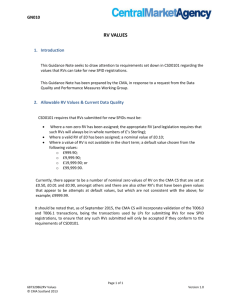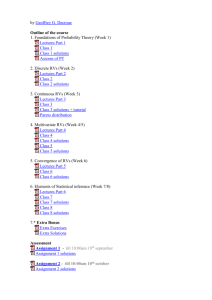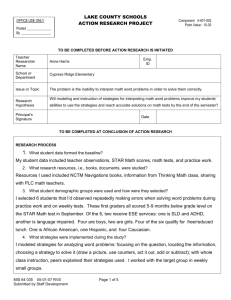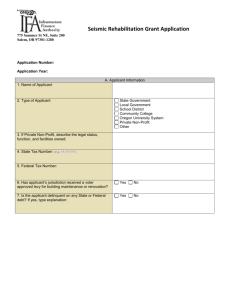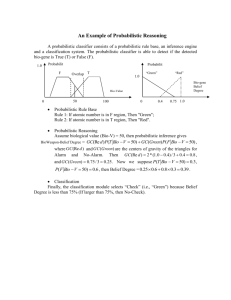Granularity Conscious Modeling for Probabilistic Databases
advertisement
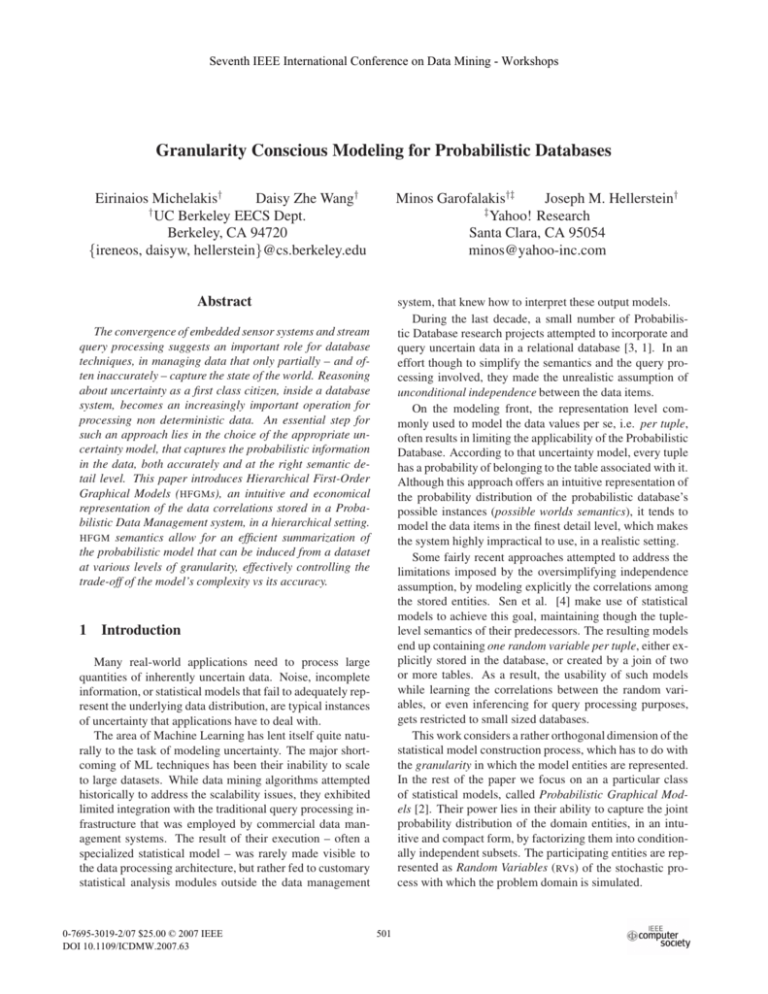
Seventh IEEE International Conference on Data Mining - Workshops
Granularity Conscious Modeling for Probabilistic Databases
Eirinaios Michelakis†
Daisy Zhe Wang†
†
UC Berkeley EECS Dept.
Berkeley, CA 94720
{ireneos, daisyw, hellerstein}@cs.berkeley.edu
Minos Garofalakis†‡
Joseph M. Hellerstein†
‡
Yahoo! Research
Santa Clara, CA 95054
minos@yahoo-inc.com
Abstract
system, that knew how to interpret these output models.
During the last decade, a small number of Probabilistic Database research projects attempted to incorporate and
query uncertain data in a relational database [3, 1]. In an
effort though to simplify the semantics and the query processing involved, they made the unrealistic assumption of
unconditional independence between the data items.
On the modeling front, the representation level commonly used to model the data values per se, i.e. per tuple,
often results in limiting the applicability of the Probabilistic
Database. According to that uncertainty model, every tuple
has a probability of belonging to the table associated with it.
Although this approach offers an intuitive representation of
the probability distribution of the probabilistic database’s
possible instances (possible worlds semantics), it tends to
model the data items in the finest detail level, which makes
the system highly impractical to use, in a realistic setting.
Some fairly recent approaches attempted to address the
limitations imposed by the oversimplifying independence
assumption, by modeling explicitly the correlations among
the stored entities. Sen et al. [4] make use of statistical
models to achieve this goal, maintaining though the tuplelevel semantics of their predecessors. The resulting models
end up containing one random variable per tuple, either explicitly stored in the database, or created by a join of two
or more tables. As a result, the usability of such models
while learning the correlations between the random variables, or even inferencing for query processing purposes,
gets restricted to small sized databases.
This work considers a rather orthogonal dimension of the
statistical model construction process, which has to do with
the granularity in which the model entities are represented.
In the rest of the paper we focus on an a particular class
of statistical models, called Probabilistic Graphical Models [2]. Their power lies in their ability to capture the joint
probability distribution of the domain entities, in an intuitive and compact form, by factorizing them into conditionally independent subsets. The participating entities are represented as Random Variables (RVs) of the stochastic process with which the problem domain is simulated.
The convergence of embedded sensor systems and stream
query processing suggests an important role for database
techniques, in managing data that only partially – and often inaccurately – capture the state of the world. Reasoning
about uncertainty as a first class citizen, inside a database
system, becomes an increasingly important operation for
processing non deterministic data. An essential step for
such an approach lies in the choice of the appropriate uncertainty model, that captures the probabilistic information
in the data, both accurately and at the right semantic detail level. This paper introduces Hierarchical First-Order
Graphical Models (HFGMs), an intuitive and economical
representation of the data correlations stored in a Probabilistic Data Management system, in a hierarchical setting.
HFGM semantics allow for an efficient summarization of
the probabilistic model that can be induced from a dataset
at various levels of granularity, effectively controlling the
trade-off of the model’s complexity vs its accuracy.
1 Introduction
Many real-world applications need to process large
quantities of inherently uncertain data. Noise, incomplete
information, or statistical models that fail to adequately represent the underlying data distribution, are typical instances
of uncertainty that applications have to deal with.
The area of Machine Learning has lent itself quite naturally to the task of modeling uncertainty. The major shortcoming of ML techniques has been their inability to scale
to large datasets. While data mining algorithms attempted
historically to address the scalability issues, they exhibited
limited integration with the traditional query processing infrastructure that was employed by commercial data management systems. The result of their execution – often a
specialized statistical model – was rarely made visible to
the data processing architecture, but rather fed to customary
statistical analysis modules outside the data management
0-7695-3019-2/07 $25.00 © 2007 IEEE
DOI 10.1109/ICDMW.2007.63
501
Unlike the majority of the most popular statistical models (classification, clustering, association rules), in graphical models the entity selection process is rarely automated,
but rather guided by expert knowledge. When the detail
level of the RVs is refined, the resulting graphical model
ends up being composed of a large set of fine-grained RVs.
Consequently, the degrees of freedom in modeling the underlying data distribution increase, and so does the complexity of the graphical model, and with it the time to learn
or perform inference on it (both problems are known to be
NP-hard [2]). Furthermore, although its fitness to the training dataset tends to be high, this often leads to overly optimistic estimates of the model’s accuracy. The latter is then
said to overfit the training data, and as a result, its generalization ability to unobserved data instances gets reduced.
This paper introduces an economical and intuitive representation of the correlation among the data stored in a
probabilistic data management system. Given a schema and
the probabilistic entities of a domain, we define the class of
Hierarchical First-Order Graphical Models (or HFGMs for
short) as a hierarchical extension of Probabilistic Graphical Models. HFGMs utilize a combination of first-order and
aggregate semantics, to model the correlations among the
probabilistic entities of a domain, in the granularity that
captures the underlying data distribution as faithfully as
possible. First order graphical modeling in the context of
databases has been addressed in [5], but that approach was
not able to capture correlations among different instances of
the same entity.
HFGMs are based on a hierarchy of RV s, which is formed
by partitioning the instances of the probabilistic database,
according to a set of “dimension” attributes. A graphical
model is derived for each level of the hierarchy, that captures the correlations among the probabilistic attributes (or
RV s), as expressed in that particular level of granularity.
We formally define HFGMs and explain how their semantics accelerate the process of deriving a finer-grained graphical model when its coarser-grained parents are already constructed, by inheriting common structure and parameters.
We finally touch upon the issues involved in learning an
HFGM from a probabilistic database.
S1
Living
Space
(R1)
RF3
600.0 mm. x
600.0 mm.
S4
Kitchen
(R2)
RF4
Bathroom
(R3)
RF1
S2
S3
S5
RF2
S6
Figure 1. Floor plan of a Digital Home.
EnvirReadings(sID, time, tempρ , lightρ , voltρ )
RFIDReadings(sID, time, numOccupantsρ)
Sensors(sID, type)
SensorLocation(sID, room, xCoord, yCoord)
Figure 2. Schema of the Digital Home DB.
[1, 100], appropriately quantized. We also consider four
RFID readers (RF1 to RF4 ), used to report the number of
occupants detected within their effective detection range.
All these readings are stored in a relational database,
with its schema shown in Figure 2. Primary keys have been
underlined, and foreign keys can be easily identified, as they
share the same names across tables. Attributes with the superscript ρ correspond to “probabilistic” attributes, encoding measurable quantities that are uncertain in our world.
The rest are treated as deterministic information.
Due to the proximity of the sensors and the various characteristics of our floor plan, a lot of correlation patterns
could be derived between the sensed quantities. For instance, since S1 and S2 are so close to the windows, it is
not unreasonable to expect that during daytime, the temperature readings of those sensors to be slightly higher than
those collected from S3 or S4 . Furthermore, at a specific
point in time, the temperature and light levels across the
living room and the kitchen should present small variability, while at all times, temperature and voltage levels in all
sensors are expected to be positively correlated.
These interesting patterns can be adequately represented
by a Bayesian or a Markov Network, which can give probabilistic estimates of the sensor values at various locations
in the room. The question that arises is the granularity with
which these correlations are represented. The temperature–
voltage and temperature–light correlations hold for each
pair of readings in the living room and kitchen (modulo
some exceptions – e.g. low light levels and increased temperature reported from S5 , since its closer to the oven), but
not in the bathroom. If the number of such exceptional
2 The Digital Home
In this section we introduce a running example to which
we will refer throughout the paper. Source of our inspiration
has been the Digital Home, a vision of a house, equipped
with sensors, able to interpret the activities of its occupants
and enhance their living quality.
Let us assume that we have a set of environmental sensors, deployed at various places in a house (see Figure 1).
Sensors S1 to S6 measure temperature, voltage and light
levels, reporting their readings as integers in the range of
502
cases is small, instead of selecting as RVs the individual
sensor readings, we could model the above patterns in a
coarser granularity, at the room level. Abstracting even further, if a particular correlation pattern is consistent across
rooms, we could capture it among the averaged values of,
say, temperature–light reading pairs of all the sensors in the
house, at a specific point in time.
HFGMs attempt to address the trade-off of expressibility vs model accuracy, by defining RVs (and thus Graphical
Models) at various levels of granularity; the models at finer
levels refine the probability distribution modeled at coarser
level models, with respect to fitting a pool of training data.
The next section gives a formal definition of HFGMs and
their semantics.
participate in a graphical model in the form a random variable ( RV), Rji , characterized by a set of domain values Vi ,
common to all the RVs of the same family.
As for the deterministic attributes Ad , each of them can
be associated with a set of domains, that specify values for
that attribute at different levels of granularity. An ordering
of these domains, from the coarsest to the finest level, defines a dimension chain, which can be used to arrange the
allowable values of the attribute into a hierarchy (see Figure
3(a) for an example). Each node in this hierarchy specifies
a unique horizontal partition of the tuples of that table. We
call the value of each node a partition key.
We can model the data falling in these horizontal partitions probabilistically, by assigning to each node of the hierarchy, a RV per probabilistic attribute, which captures the
values that correspond to the latter at the level of granularity that this node resides in the hierarchy. Thus, considering
a single dimension attribute1 and k probabilistic ones, will
give rise to k identical RV hierarchies, each corresponding
to one of the probabilistic attributes. Each such hierarchy
is associated with a particular family of RVs, and hence, its
nodes are the RVs that belong in the family.
More formally, a Hierarchy H(Ri ) of a family of RVs Ri
defines a partial ordering relationship ≺ between its member RVs. For each Rji ∈ Ri , C(Rji ) denotes the set of the
immediate subclasses (or children) of Rji , as defined by the
partial ordering ≺. x ≺C y, denotes that x is an immediate subclass of y, while with ≺∗ we symbolize the transitive
closure of ≺; if x ≺ y, x is a (not necessarily immediate)
subclass of y.
The scope S(Rji ) of the RV Rji specifies its value for
every independent trial (or instance) stored in the database.
This value is an aggregate over the values of its immediate
children Rki , Rki ∈ C(Rji ), that fall in the horizontal partition of the hierarchical level l in which Rji belongs. More
formally, we define S(Rji ) in terms of Relational Algebra
operators as: S(Rji ) = γ(σ(< list of predicates >), Aid ),
where γ represents the aggregation operator, σ an equality
selection over the list of dimension attributes which define
Rji , and Aid the deterministic attribute used to identify the
independent trials of the stochastic process that the probabilistic database models.
We conclude this definition section with the notions of
compatibility and identity, which are key to HFGM semantics. Two hierarchies are compatible if they share the same
dimension chain. Two hierarchies are identical if they are
compatible and share the same tree structure (ie. there is
a one-to-one mapping between their RVs at each level, and
the partition key of each RV pair is the same).
3 Hierarchical FO Graphical Models
A HFGM is composed of two parts: a hierarchy of random variables (RVs) H corresponding to the probabilistic
attributes of the domain, and a number of layered FirstOrder Graphical Models M∗ = {M1 , . . . , Mn }, which
describe the dependencies among the RVs of H. The RVs at
each Mi reside in the same hierarchical level in H. Before
introducing the HFGM formalism, we will briefly define our
notion of a Probabilistic Relational Database.
A Probabilistic Relational Schema S p is an extension of
a Relational Schema that identifies for each participating
relation R = {A1 , . . . , An }, a non-empty subset Ad ∈ R
of deterministic and a subset Ap ∈ R of probabilistic attributes. For the deterministic attributes of R there is no
uncertainty concerning their values. In that respect, their
functionality is very similar to the the dimension attributes
of the multidimensional OLAP paradigm. For the probabilistic attributes, it is assumed that their values are uncertain; thus, they can be seen as instances or measurements,
taken from random experiments of a stochastic process.
Thus, we formally define a Probabilistic Database with
schema S p , as a set of independent and identically distributed (IID) trials of a stochastic process. This interpretation allows us to group the values of the probabilistic attributes in the database into a number of distinct, independent trials of this process.
3.1
Random Variables Hierarchy H
A domain D consists of a set of basic entities,
E ∗ = {E1 , . . . , El }, representing the probabilistic attributes
{Ap1 , . . . , Apl } of a Probabilistic Relational Schema S p .
Each entity Ei can be further refined into a family of entities of various granularities, Ei = {Ei1 , . . . , Eik }, that share
the same semantics (i.e. model the same physical world
quantity), but in different levels of detail. An entity Eij can
1 For simplicity of exposition, we consider a single dimension attribute
per probabilistic relation. An extension of this scheme to the multidimensional model introduced by the OLAP paradigm, represents an interesting
future work direction.
503
ALL
T
Room
Sensor
(a)
T@1
TS1
TS2
T@2
TS3
T@3
TS4
(b)
tween a set of RVs (the nodes of the graph), and a set of conditional independence relationships among them, encoded
by the edges set E. A First-Order Graphical Model extends the above formalism by encoding dependencies between populations of RVs. Its definition is tightly integrated
with the existence of a hierarchy of RVs H, in the sense that
each RV Ri can have a set of RVs Rij that are regarded its
descendants, defined at a finer granularity level than Ri in
H – more formally, Rij ∈ C(Ri ).
Two or more RVs can be joined by edges that represent their correlation patterns, only when they belong to the
same granularity level of two compatible hierarchies (or the
same one). Nevertheless, such a correlation can have two
distinct interpretations, based on the relation of the connected RVs with respect to their hierarchies:
RF
TS5
RF@1
TS6
RF1
RF2
RF@2
RF3
RF@3
RF4
(c)
Figure 3. The hierarchy of the RVs of the Digital Home domain: (a)The common dimension
chain of H(T ), H(V ), H(L)&H(RF ); (b) H(T );
(c) H(RF ).
Example In our Digital Home domain (see Fig. 2), the
basic probabilistic entities are the temperature (T ), sensor voltage (V ), light levels (L) and the number of people
present (RF ) at a specific region of the house. Their RVequivalents correspond to the roots of four hierarchies of
RV s. Their scope consists of all the aggregate temperature,
voltage, light level readings and person counts respectively,
from all the sensors in the house, at the time instances the
data collection took place.
At a finer detail level, partitioning SensorReadings according to the sensor’s location would be a reasonable refinement. Each of our base hierarchies would be extended
with a second level of RVs, corresponding to the aggregated
temperature / voltage / light-level / people-presence readings for a particular room (e.g. for the temperature hierarchy, the RVs T @1, T @2 and T @3 would be created, for
the temperature readings in the living room, kitchen and the
bathroom respectively, with the partial ordering relationship
{T @1, T @2, T @3} ≺C T holding). Further refining the detail of the representation to the sensor level is quite straightforward. Figures 3(b) and 3(c) depict the hierarchies of the
T and RF RVs of our example.
The notion of granularity of a RV Ri is ultimately realized by aggregating at every independent trial the values of
its children RVs, C(Ri ). Let γ(P, Aid ) denote the aggregation of partition P on the deterministic attribute set Aid . In
our example, a stochastic trial is uniquely identified by its
time-stamp (attributes EnvirReadings.time and RFIDReadings.time in our example). Thus, the RV T @1 is defined as
the average of its children (T S1, T S2 and T S3), per time
instance, thus representing a coarser-level abstraction – a
probabilistic summary – of the temperature readings collected in room 1.
3.2
• Templating: If the RVs have identical hierarchies, the
correlation also holds for the children of the correlated
variables (e.g. T @1 − L@1 is translated as T Si − LSi ,
for i = 1, . . . , 3). The model is said to display “firstorder” logic semantics, since each dependency structure is universally quantified over its children.
• Aggregation: If the RVs have simply compatible hierarchies but different partition keys, the correlation
specified at that level represents an aggregate correlation, through which – and not directly – the children of
these RVs are correlated (e.g. T @1 − T @2). No oneto-one correlation (ie. templating) between the children of the RVs involved can be assumed. Thus, in our
example, the children of T @1 and T @2 are correlated
implicitly, through their parents, at a coarser granularity level.
First-Order Graphical Models constitute a more expressive and economic representation of the correlation patterns
among populations of RVs that share similar characteristics
and interactions. In this paper we focus on directed graphical models. The following section presents the extension of
the widely used Bayesian Network formalism, by incorporating the aforementioned semantics.
3.2.1 First-Order Bayesian Networks
As in the classical Bayesian Networks, by taking into account the conditional independence assumptions encoded
in the graph’s structure, we can define a probability distribution over all the valid instantiations of the RVs of the
model, as a product of the local conditional probabilities of
its nodes, given their parents. Thus:
p(RV ) =
p(Ru |P a(Ru )),
(1)
First-Order Graphical Models
The second component of an HFGM is a set of FirstOrder Graphical Models, each corresponding to a level of
the hierarchy of RVs presented in the previous section. A
Probabilistic Graphical Model is a graph G = (V, E) be-
u∈V
where P a(Ru ) is the set of the parental nodes of Ru .
504
Definition 1 A First-Order Bayesian Network (FBN) is
defined as follows. Given a number of compatible entity hierarchies H, and a set of RVs R, drawn from a specific level
l of these hierarchies, we introduce for each RV Ri ∈ R:
• a set of parents nodes P a(Ri ) =
V
T
L
RF
Level ‘ALL’
V@1
L@1
T@3
{Rπ1 i , . . . , Rπk i };
L@2
V@2
T@2
T@1
T@2
L@1
L@2
RF@1
L@3
Level ‘Room’
V@3
L@3
RF@3
RF@2
VS1
• a conditional probability table φl (Ri ) (CPT) that represents the local probability distribution defined by the
RV Ri and its parents, p(Ri |P a(Ri ));
TS1
LS1
Avg
L@1
Avg
L@2
VS4
RF2
VS2
TS1
TS2
TS3
TS2
LS2
L@1
LS1
LS2
LS4
TS4
LS5
TS5
L@2
VS5
VS3
LS3
TS3
• an inherited indicator, specifying a CPT φl (Ri ) from
the FBN Ml of a previous level l < l, which may act
as a template according to the first order semantics;
RF2
LS3
RF1
RF4
RF3
LS6
TS6
Level ‘Sensor’
VS6
Figure 4. A 3-level HFBN for the Digital Home
domain.
• an aggregate indicator, which points to an ancestor RV
at a coarser hierarchical level l < l, iff that RV participates in an aggregate correlation at level l 3.3
T@3
Hierarchical FO Bayesian Networks
further structural refinements may be present. In the same
example, we see that L@1 and L@2 appear correlated, an
example of an aggregate correlation, which could not be
captured by M1 at the previous abstraction level.
As Figure 4 suggests (left column of the figure for the
FBN s at levels 2 and 3), correlations that carry over from
coarser granularity FBNs, do not need to be explicitly modeled again. Only exceptions have to be specified at each
level of granularity. This compact representation, not only
results in a more intuitive graphical model formalism, but
also is indicative of the amount of the state that is required
to store the FBNs at each level of the hierarchy.
With regards to inferencing, for a probabilistic query that
involves RVs from various granularity levels, one has to go
to the FBN at the level corresponding to the finest-grained
RV in the query, Mi , and create a ground BN , incorporating inherited and aggregated correlations recursively, from
all the coarser grained FBNs (M1 , . . . , Mi−1 ). In Figure
4 the ground BNs for the second and third level appear to
the right of their corresponding FBNs. First-order inferencing techniques can also be applied, so that inference can be
accelerated [6].
For inherited correlations, grounding results in replication of the same correlation patterns among the descendants
of the abstracted RVs, and copying the CPTs of the parent
nodes to their descendants. Inherited correlations can be
overridden by exceptions at any finer level FBN.
Grounding aggregated correlations proves to be a more
complicated process. In Figure 4, at the second level, the
edge between L@1 and L@2 represents an aggregate correlation between the average light levels of rooms 1 and
2. If we ground the FBN M3 , we notice that the keys
of the partitions corresponding to the finer grained RVs
LS1, LS2, LS3 and LS4, LS5 are not the same (clearly
here, no semantically valid one-to-one mapping can be
found between these two groups of RVs). Although these
Having described their constituents, we define a HFBN
as a hierarchy of First-Order Bayesian Networks M∗ =
{M1 , . . . , Mn }. Each FBN corresponds to the aggregation
level of the dimension chain of the hierarchy H(RV ), that
the participating RVs RV ⊆ R belong to.
Based on the first-order semantics described above, we
can represent the FBNs that comprise an HFBN in a more intuitive way: interconnections of RVs at levels {1, . . . , i − 1}
that form templates, imply the same sets of correlations,
with the same CPTs, between their decedent RVs which participate at the next level network Mi . These finer-grained
RV s do not need to be explicitly represented. As a result,
we gain significant computational and spatial savings during both learning and inferencing, since the inherited factors
do not need to be explicitly replicated or recomputed. Aggregated correlations at more abstract levels are again not
represented in Mi .
HFBN s do not preclude the existence of exceptions to an
abstract correlation pattern that is captured at a coarser granularity network. Let us look at an example HFBN, which is
depicted in Figure 4. Inherited and aggregate correlations
are symbolized by dotted and bolded edges respectively.
At the most abstract level, M1 encodes a pairwise correlation pattern between average temperature, light level and
voltage readings among all the environmental sensors in the
deployment. In addition, RV RF is assumed to be independent of the all the others. While this is true for the majority
of the sensors, there exist some cases, like T @3 and L@3
(average temperature and light at room 3) that the above correlation patterns do not hold. Since the high “compression
ratio” imposed by the coarse granularity of the RVs in M1
cannot support modeling information in finer detail levels,
we expand our HFBN by introducing this refinement in a
finer granularity level (model M2 ). Apart from exceptions,
505
5 RVs can not be directly correlated, they are correlated at a
more abstract level, through L@1 and L@2.
In terms of parameterization, the factorization of the
ground Bayesian Network of level 3 will also contain
the aggregated conditional probability between the coarser
level RVs L@1 and L@2. The problem lies in binding the
contribution of the aggregate potential p(L@2|L@1) with
the finer grained potentials in the overall parameterization.
Essentially, the coarse-grained RV L@1 and its children
LS1, LS2 and LS3 are deterministically dependent on each
other by the aggregate function γ(.) used to define the scope
of L@1 (in our example S(L@1) = γ(LS1, LS2, LS3) =
avg(LS1, LS2, LS3)). The same holds for L@2 and its
children RVs.
Mixing deterministic and probabilistic correlations in a
graphical model conflicts with its default parameterization,
as the deterministic correlations prohibit all incompatible
assignments of values to the nodes in the network (e.g. any
assignment on LS1, LS2, LS3 and L@1 which invalidates
the deterministic constraint LS1+LS2+LS3
= L@1). To
3
overcome this problem we introduce two auxiliary binary
RV s, AvgL@1 and AvgL@2, that capture the deterministic
constraints of L@1 and L@2 with their respective children.
More formally, for every deterministic constraint D(R)
that involves a set of RVs R, we introduce the binary auxiliary variable AuxR, with CPT defined as follows:
P r(AuxR = 1|R) =
1 if R satisfies D(R);
0 otherwise.
process has to consider, apart from edge additions as its basic operator, removals of inherited edges, and even recomputations of the inherited or aggregate CPTs.
Our learning algorithm essentially performs a top-down
greedy search to construct the FBN at each hierarchical
level, by first inheriting the existing template or aggregate
correlations from the previous level FBN. The resulting
model gets evaluated and then possible perturbations of the
inherited structure and parameters are considered, to identify exceptions. The algorithm terminates when a prespecified accuracy vs. model complexity condition is met. A
more detailed description of the algorithm is provided in
the full version of the paper.
5 Conclusions and Future Work
In this paper we presented HFGMs, a Probabilistic Graphical Modeling formalism which provides the means for an
economical and intuitive representation of the correlations
among the data, in a Probabilistic Database System. Guided
by a set of hierarchical dimensions that partition the probabilistic values of the database in regions of varying granularity, HFGMs utilize a combination of first-order and aggregate semantics, to model the correlations among these
values, in the granularity that captures the underlying data
distribution as faithfully as possible. Through the succinct
representation of uncertain data correlation they employ,
HFGMs enable the construction of practical Probabilistic
Database Systems, which can scale to large datasets, without having to resort to unrealistic statistical models, like full
independence, which limit their applicability. We plan to
extend our formalism to multiple hierarchical dimensions,
and to also support Markov Networks as an additional underlying graphical modeling framework, so that a larger
family of probability distributions can be modeled.
(2)
One can easily verify that the FBN resulting from the incorporation of these auxiliary variables, can be used to perform inference on the set of RVs of the problem’s domain,
by simply conditioning the auxiliary RVs AuxR to be true
(i.e. P r(R) = P r(R|AuxR = 1)).
References
4 Learning HFGMs
[1] O. Benjelloun, A. D. Sarma, A. Halevy, and J. Widom. Uldbs:
Databases with uncertainty and lineage. In Proceedings of the
32nd VLDB Conference, Seoul, Korea, 2006.
[2] D. Chickering, D. Geiger, and D. Heckerman. Learning
Bayesian Networks is NP-Hard. Technical Report MSR-TR94-17, 1994.
[3] N. Dalvi and D. Suciu. Efficient query evaluation on probabilistic databases. VLDB Journal, 2006.
[4] A. Deshpande and P. Sen. Representing and querying correlated tuples in probabilistic databases. In 23rd International
Conference on Data Engineering, Istanbul, Turkey, 2007.
[5] L. Getoor, N. Friedman, D. Koller, and A. Pfeffer. Learning probabilistic relational models. Relational Data Mining,
2001.
[6] D. Poole. First-order probabilistic inference. In Proceedings
of the 2003 International Joint Conferene on Artificial Intelligence (IJCAI), 2003.
Graphical model learning from complete datasets has
been proven a substantially challenging task. It involves
inducing the structure and the parameters of the model, and
because of the NP-Hardness of the process [2], the problem is attacked by heuristically navigating through the big
search space of candidate models, for the one that maximizes the likelihood to the training data.
Learning HFBNs involves a considerably larger search
space; as the RV hierarchies get deeper or the number of
dimensions gets larger, the number of RVs at each level increases dramatically, with negative impact to the structure
learning process. Also, in order to support exceptions to the
correlations inherited by coarser-grained FBNs, the learning
506

